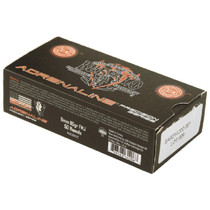The Myth of the “All-Natural Buck” - Feed Minerals NOW, Not This Fall
Posted by Fin Feather Fur Outfitters on Feb 10th 2022

We talk to a lot of deer hunters at our stores, and we have heard some say that they do not use feed or minerals because it’s not natural and that deer can get everything they need from their natural diet. First off, anyone that thinks deer do not naturally seek out minerals should read Mineral Licks, Geophagy, and Biogeochemistry of North American Ungulates book. It contains detailed accounts of large mammals seeking areas of concentrated minerals in the soil. Secondly, natural habitat is becoming extinct. I can think of 7.6 billion reasons why there isn’t natural habitat like there used to be. When humans alter landscapes, natural deer forage cycles are interrupted. The good part about deer is that they are very adaptable and can thrive in environments that are far from “natural.”
Think about an agricultural bean field for instance. In the spring there is
almost zero forage available. By
mid-summer there is abundant green leafy forage, and by mid-October there are
millions of bean pods for the taking, until harvest that is. After harvest the available pod count goes
from millions back to almost nothing due to the efficiency of modern farm
machinery. The deer that live in agricultural
landscapes must be getting enough because they grow some monster bucks in Iowa,
Illinois, Minnesota, Ohio, etc… but what if they weren’t? What if they could be even bigger? What if those big mature bucks could be given
all the minerals they need? Then you could really see some world class antler
growth!
Through internal research at Ani-Logics Outdoors, they have yet to find a buck
that “has it all” in terms of circulating mineral levels. Most deer managers
talk a lot about calcium and phosphorous as being important for antler growth
mainly because if you grind up an antler, those are the two most prevalent minerals. Interestingly,
they found that deer were not deficient in calcium or phosphorus. Deer could get enough of each from what they were
eating. Obviously, calcium and
phosphorus are important, but what is more important are the micro minerals
that they found to be deficient in their diet.
Those micro minerals were zinc, copper, manganese, and selenium. The concept of limiting factors is not new to
science. The theory is called Liebig’s Law
of the minimum which states that growth is controlled not by the total amount
of resources, but only by the scarcest resource (the limiting factor). In the case of deer, the limiting factor is
not consistent across their range. In
some areas it is copper, and in other areas it is zinc. Depending on where you are in the US, it
could be a whole host of other minerals that are limiting. Here is a map of zinc concentrations in the
first 5 cm of soil.

Notice how the concentration of zinc differs in the soil across the US. You can see where the Mississippi river
valley contains higher concentrations of zinc and it’s interesting that both of
the well-known big buck counties (Buffalo County WI and Pike County IL) have
higher concentrations of zinc. You can
even see where Sumner county TN has a pocket of higher zinc. That is where Stephen Tucker took the largest
non-typical buck ever harvested by a hunter.
After you fill the limiting factors, you see some significant increases in
antler growth. Look at the deer that
Mark Drury has killed on his Iowa farm the last several years. He has hunted that same farm for 25 years and
never shot a 200” buck. Then he started using
Ani-Logic’s scientifically formulated feed which contains the proper ratio of
micro minerals and now within the last 3 years he has killed 2 bucks over 200
inches! These bucks were not “all-natural”
but that’s fine with Mark. He knows that
if deer do not get everything they need for antler growth from natural forage,
it is perfectly normal to supplement the diet.
It goes to show that when you put the proper science into a supplement
product, the results speak for themselves.
As a land/deer manager now is the time to start feeding minerals. Not late fall.
MORE RECENT BLOGS












